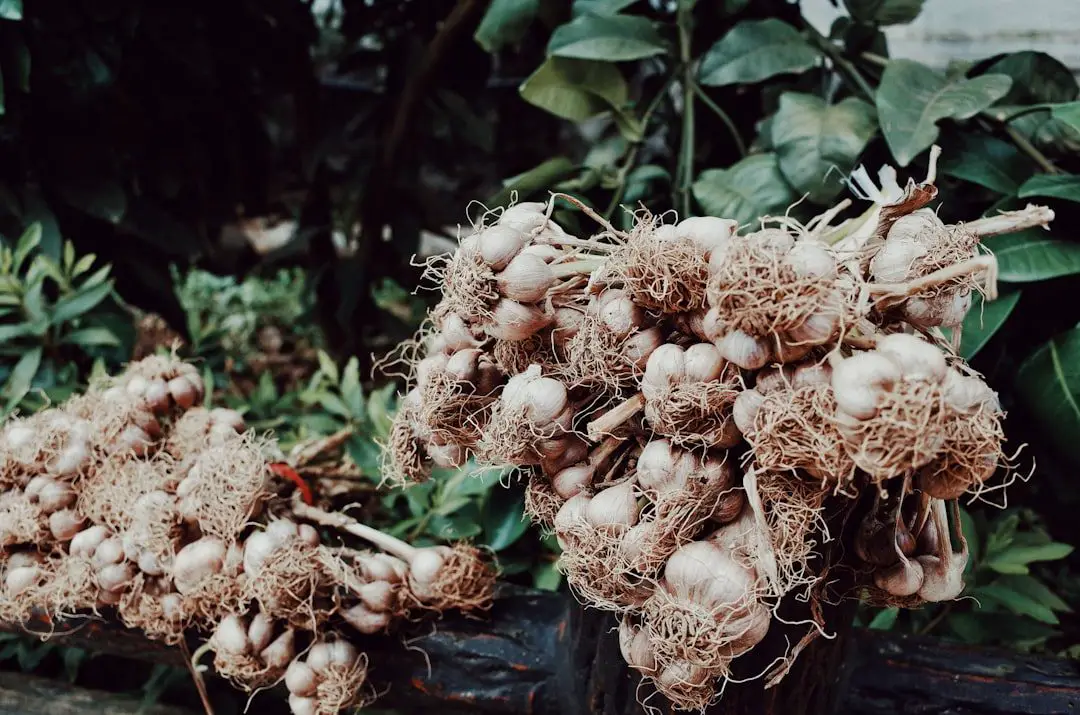
Garlic is a versatile ingredient that has been used in cooking and medicine for centuries. Its distinct flavor and aroma make it a must-have in every kitchen, while its medicinal properties have made it a staple in traditional remedies. In this article, we will explore the various aspects of garlic, from its different varieties and flavors to its health benefits and culinary uses. We will also delve into the historical significance of garlic and its role in different cuisines around the world.
Key Takeaways
- Garlic is a versatile ingredient that should be a staple in every kitchen.
- Different varieties of garlic offer unique flavors, from mild to bold.
- Garlic has numerous health benefits and should be added to your diet.
- Garlic is a staple ingredient in the Mediterranean diet and healthy eating.
- Tips and tricks for cooking with garlic can elevate your dishes.
The Versatility of Garlic: A Must-Have Ingredient in Every Kitchen
Garlic is not only a flavor enhancer but also a natural remedy for various ailments. It adds depth and complexity to dishes, whether used fresh, dried, powdered, or in oil form. Fresh garlic has a pungent and sharp flavor, while dried garlic has a milder taste. Garlic powder is a convenient option for adding garlic flavor to dishes without the hassle of peeling and chopping cloves. Garlic-infused oil is another popular way to incorporate garlic into cooking.
Garlic is used in cuisines all over the world, from Italian pasta dishes to Indian curries. It is a key ingredient in many traditional recipes, such as French aioli, Chinese stir-fries, and Mexican salsas. Its versatility allows it to be used in both savory and sweet dishes, adding depth and complexity to everything from soups and stews to desserts like garlic ice cream.
From Mild to Bold: Different Varieties of Garlic and Their Unique Flavors
There are hundreds of varieties of garlic, each with its own distinct flavor, aroma, and appearance. Softneck garlic varieties are milder in taste and have a longer shelf life, making them ideal for braiding and storing. Hardneck garlic varieties have a bolder flavor and are known for their large cloves. Elephant garlic, although not a true garlic but rather a member of the leek family, has a mild and sweet flavor.
The best uses for each variety of garlic depend on their flavor profiles. Mild varieties are great for dishes where you want a subtle garlic flavor, such as salad dressings and marinades. Bolder varieties are perfect for dishes that require a strong garlic presence, like roasted meats and garlic bread. Experimenting with different varieties of garlic can add depth and complexity to your dishes.
The Health Benefits of Garlic: Why You Should Add It to Your Diet
| Health Benefit | Description |
|---|---|
| Reduces Blood Pressure | Garlic contains compounds that help relax blood vessels and reduce blood pressure. |
| Boosts the immune system | Garlic has antibacterial and antiviral properties that can help strengthen the immune system. |
| Improves Cholesterol Levels | Garlic can help lower LDL (bad) cholesterol levels and increase HDL (good) cholesterol levels. |
| May Reduce Risk of Cancer | Studies have shown that garlic may have cancer-fighting properties and may reduce the risk of certain types of cancer. |
| May Improve Bone Health | Garlic contains nutrients that may help improve bone health and reduce the risk of osteoporosis. |
| May Improve Brain Function | Garlic may have neuroprotective properties that can help improve brain function and reduce the risk of cognitive decline. |
Garlic has been used for centuries for its medicinal properties. It is rich in antioxidants and contains compounds that have been shown to have antibacterial, antiviral, and antifungal properties. Studies have also shown that garlic can help lower cholesterol levels, reduce blood pressure, and boost the immune system.
The recommended daily intake of garlic varies depending on the individual’s health goals and tolerance. Some studies suggest that consuming one to two cloves of garlic per day can provide health benefits. However, it is important to note that excessive consumption of garlic can cause digestive issues and may interact with certain medications. It is always best to consult with a healthcare professional before making any significant changes to your diet.
Garlic in the Mediterranean Diet: A Staple Ingredient in Healthy Eating
Garlic plays a prominent role in the Mediterranean diet, which is known for its emphasis on fresh fruits and vegetables, whole grains, legumes, and healthy fats. Garlic is used in many traditional Mediterranean dishes, such as Greek tzatziki sauce, Italian bruschetta, and Spanish gazpacho.
The Mediterranean diet has been associated with numerous health benefits, including reduced risk of heart disease, stroke, and certain types of cancer. Garlic’s inclusion in this diet adds not only flavor but also potential health benefits. Incorporating more garlic into your diet can be a simple way to adopt a healthier eating pattern.
Garlic and Its Culinary Uses: Tips and Tricks for Cooking with Garlic

Properly preparing garlic is essential for maximizing its flavor. To peel garlic cloves easily, place them on a cutting board and press down firmly with the flat side of a knife. This will loosen the skin, making it easier to remove. To chop garlic, use a sharp knife and mince it finely to release its full flavor.
Garlic can be cooked using various methods, each resulting in a different flavor profile. Roasting garlic brings out its natural sweetness and mellows its pungency. Sautéing garlic in oil or butter adds depth and richness to dishes. It is important to avoid burning garlic, as it can become bitter and ruin the flavor of the dish. To prevent burning, cook garlic over low to medium heat and remove it from the heat as soon as it turns golden brown.
Garlic in International Cuisine: How Different Cultures Use Garlic in Their Dishes
Garlic is used in a wide range of international cuisines, each with its own unique approach to incorporating this flavorful ingredient. In Asian cuisine, garlic is often used in stir-fries, soups, and sauces. It is also a key component of many Indian curries and spice blends. In African cuisine, garlic is used in stews, marinades, and spice rubs. South American cuisine incorporates garlic into dishes like chimichurri sauce and ceviche.
Each culture has its own unique garlic-based dishes that showcase the versatility of this ingredient. From Korean kimchi to Lebanese toum (garlic sauce), these dishes highlight the cultural significance of garlic and its ability to elevate the flavors of traditional recipes.
Garlic and Its Pairings: The Best Ingredients to Combine with Garlic
Garlic has a strong flavor that can overpower other ingredients if not balanced properly. When pairing garlic with other ingredients, it is important to consider their flavor profiles and how they complement each other. Some ingredients that pair well with garlic include onions, tomatoes, herbs like parsley and basil, and citrus fruits like lemon and lime.
Recipes that feature garlic and complementary ingredients include classic dishes like spaghetti aglio e olio, where garlic is paired with olive oil, chili flakes, and parsley. Garlic also pairs well with seafood, such as shrimp scampi or garlic-butter salmon. Balancing the flavors of garlic with other ingredients can create a harmonious and delicious dish.
Garlic and Its Preservation: How to Store Garlic for Maximum Freshness
Proper storage is essential for preserving the freshness of garlic. Whole bulbs of garlic should be stored in a cool, dry place with good air circulation, such as a pantry or a kitchen cabinet. Avoid storing garlic in the refrigerator, as the moisture can cause it to sprout or become moldy.
To extend the shelf life of peeled or chopped garlic, store it in an airtight container in the refrigerator. Alternatively, you can freeze peeled cloves or chopped garlic in ice cube trays with a little water or oil. This allows you to easily portion out small amounts of garlic for future use.
Garlic in Condiments and Sauces: Elevating Your Meals with Garlic-Based Seasonings
Garlic is a key ingredient in many popular condiments and sauces that are used to enhance the flavor of dishes. Pesto, a classic Italian sauce made with basil, pine nuts, Parmesan cheese, olive oil, and garlic, adds a burst of flavor to pasta, sandwiches, and roasted vegetables. Aioli, a creamy garlic sauce made with mayonnaise and garlic, is commonly used as a dip for fries or a spread for sandwiches.
Making your own garlic-based condiments and sauces allows you to customize the flavors to your liking. You can experiment with different herbs, spices, and additional ingredients to create unique variations of these classic sauces.
Garlic and Its Historical Significance: Tracing the Origins of Garlic in Cooking and Medicine
Garlic has a long history of use in both cooking and medicine. It has been cultivated for over 5,000 years and was highly valued by ancient civilizations for its medicinal properties. In ancient Egypt, garlic was used as a dietary supplement for the workers who built the pyramids. It was also used by the ancient Greeks and Romans for its healing properties.
Throughout history, garlic has been associated with various cultural beliefs and superstitions. It was believed to ward off evil spirits, protect against vampires, and even enhance athletic performance. Today, garlic continues to be revered for its culinary and medicinal uses, with ongoing research exploring its potential health benefits.
Garlic is a versatile ingredient that adds depth and complexity to dishes while offering numerous health benefits. Its unique flavor and aroma make it a must-have in every kitchen, whether used in traditional recipes or experimental creations. From its different varieties and flavors to its historical and cultural significance in different cuisines, garlic continues to be an essential ingredient in cooking and medicine. So next time you reach for that bulb of garlic, remember the rich history and versatility that this humble ingredient brings to your meals.
If you’re a fan of garlic seasonings, you’ll definitely want to check out this fascinating article on the benefits and extractions of birch sap. Discover deeper insights into this unique ingredient and how it can enhance your culinary creations. From its natural sweetness to its potential health benefits, birch sap is a must-try for any food enthusiast. Dive into the world of birch sap by clicking here and unlock a whole new level of flavor in your dishes.



